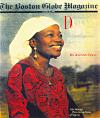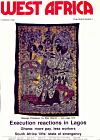
In New African Magazine, Julie Kitchener writes: "Nigerian artist Nike respects Picasso's doctrine that
'it is good for an artist to copy another artist, but not good for
an artist to copy themselves'. Despite her distinctively personal
style, there is little repetition - even down to color
combinations - in her fabulous batik work, and she never
reproduces her fashion designs... Nike travels widely in Europe
and the USA as well as in Africa: 'Maybe three or four times a
year. I love meeting people. When you sit in one place your ideas
stay in that place'. There is nothing static or rigid about Nike's
work. It is imbued with the dynamism of her imagination and the
animation of her conversation. Her designs tell tales, recorded
from her unconscious in her dreams which she draws directly onto
the cloth, from traditional fables, or from her most recent
experiences - 'Jazz, dancers or even the movies in America' have
influenced her".
In the catalogue 'Oshogbo Art:
Batik of Nike and Work on Paper from Oshogbo', Victoria Scott
acknowledges Nike as Nigeria's leading female artist, whose
"output is prodigious" and "imagination
unfailing". Scott writes that "Nike learned the
discipline required for her complex decorative patterning from the
traditional adire artists, but she invented new patterns to suit
her own needs and the demands of her chosen media".
Network Africa magazine
described Nike as "Nigeria's leading batik artist. Her
work has been heralded as an example to encourage more women to
enter the art field. Nike works in the modern context using
traditional techniques and imagery. Her efforts are directed
toward preserving the Yoruba culture through contemporary
art".
Robert Press in the Christian
Science Monitor writes about Nike's Centre: "It is here
that Nigerian artist Nike Davies is providing high quality
training in the arts - free of charge. She and master teachers at
her centre teach sculpture and relief carving, painting,
embroidered tapestry, batik, adire (a batik like method using
cassava paste instead of wax), appliqué (sewing cloth on cloth),
pen and ink on cloth or paper, quilting, drum making and dancing.
By her training and her marketing efforts both in Africa and
abroad, Nike is helping her students fight some of the major
challenges to African art today; a poor economy, which limits what
most Africans can afford; and a strong taste for anything Western,
including cheap, often second hand clothing and pirated
musical-cassette tapes".
In West Africa magazine Dinah
Anuli Butler wrote: "The work hasn't always made her
(Nike) an adequate living and at times she has worked until two in
the morning to finish something in the hope that she would be able
to sell it. At other times, having hardly any money, she would
fast for three days and pray. Her faith was always rewarded. This
has been another quiding principle for her. It is perhaps this
faith, that has enabled her to be so free in her art so there are
always new ideas, new approaches. It is not a source to be
drained. Her starch-resist work was popular but she went onto wax
and from there to water colour and then acrylic. She also wants to
try collage. Her flow of energy is also extended to teaching. Nike
holds workshops in the course of her travels with her work".
Juliet Highet in "African
Renaissance: Contemporary Nigerian Art from Oshogbo and Ile-Ife"
wrote: "Nike represents the new breed of African woman
artist, many of whose realities are now international, though in
essence they are perpetuating the living tradition of female
artists and 'cloth-queens', controlling heady empires of fabric -
wealthy powerful women. Nike's concerns may differ and her range
of techniques may have expanded from those of their ancestors, but
they are still working with cloth... The passion of her life, she
declares, is to help emancipate Nigerian women through art. She
had an extremely tough early life, and having broken free of an
unhappy first marriage, is determined to inspire other women to
expand their horizons. 'The resurgence of interest in local cloth
in Nigeria is helping women to become more financially
independent' she said. 'If I hadn't done all this work, I would
never have got my independence. Most of the women who are not
dependent on the whim of their husbands to provide have struggled
and worked hard, mostly at weaving, and batik and Adire in the
countryside. The women are enjoying it too! Part of my aim in
doing Adire is to bring the whole thing back again. People
appreciate it now, but before they used to say - 'This is made in
Nigeria - we don't want it'."
"Discussing the fact that the
patronage of Oshogbo art has by and large shifted from expatriates
in Nigeria to the indigens themselves, Nike said: 'formerly
Nigerians didn't think much of our work, but nowadays the majority
of our output, particularly the expensive pieces, are bought by
Nigerians. When they travel abroad and see our work in big offices
or posh homes, they will come and look for the artist. Then their
houses, they want to decorate with Nigerian art. After the ban on
imported goods in the '70s, since then Adire Eleko has become a
big seller in Nigeria, which few bought before. People are
returning to tradition and enjoying it. They are always looking
for our batiks, which in turn encourages the work of our women,
because it's mostly women that produce cloth here'."
"To each of the Oshogbo and
Ife artists I addressed the same question: 'What does contemporary
Nigerian art have to say to the world?' I was particularly
interested in how an internationally renowned and well-travelled
artist like Nike would respond, and indeed she gave me an answer
that betrayed her awareness of the global art market and it's
commercial possibilities. 'Most of the people in the West who are
interested in African art have been collecting antiquities and I
think they should start investigating our modern art. One day this
contemporary art will be recognized for its worth and will fetch
high prices, like antiques. To uninformed people, our art is new,
but it is strong and good and will become old one day'. Indeed
early works by Twins Seven Seven change hands nowadays for
thousand of dollars."
Here's Nike herself with the
final word: "Looking back today, art has been good to me.
Though at first there was no money in it, it was the
interest that kept me going. There were times I wouldn't eat for
two days simply because I have used the money meant for food to
buy dye. Today I am happy that I have made a name throughout the
world. Americans think I have 'A wonderful hand' - they call me
'the woman with magic hands'. My dream is to spread African arts
throughout the world; and to let the unborn generations know that
our culture is very rich".
|










![]()